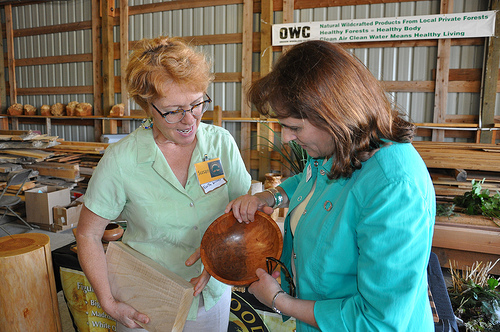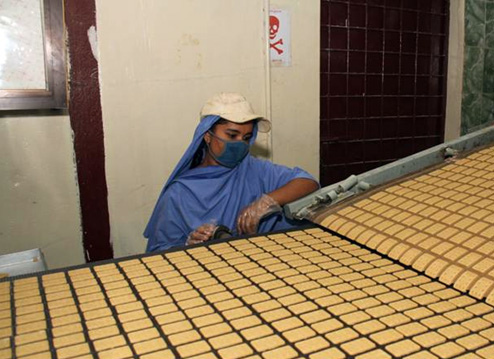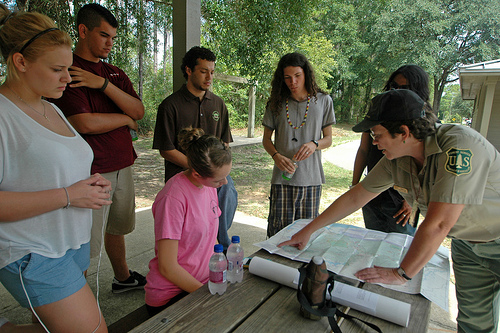
Susan Curington of North Woods Figured Woods (left) shows State Director Vicki Walker (right) how the family business “upcycles” burls, stumps and small, odd-shaped, or difficult-to-use wood pieces to be sold at premium prices to carvers and other hobbyists. USDA photo.
At a recent expo held by the Oregon Woodland Cooperative (OWC), I had the opportunity to meet with a number of family forest landowners who are cultivating additional commercial ventures thanks, in part, to USDA’s Value Added Producer Grant (VAPG) program.
At the event, OWC President Neil Schroeder introduced me to cooperative members who have sprouted new businesses and created local jobs as a result. The terrific part of all this is that USDA’s VAPG program provided funds needed to conduct the in-field assessments, feasibility studies, business planning, and marketing activities needed to identify, process and sell new, non-lumber products harvested from Oregon’s family forests. Read more »

A Bangladeshi factory worker monitors the production of biscuits made from U.S. donated wheat. The donation was delivered to the World Food Programme, a Foreign Agricultural Service (FAS) McGovern-Dole program participant that works to provide food assistance in more than 73 countries. The biscuits will be distributed to about 2,000 schools in the poorest areas of Bangladesh. (Photo courtesy U.S. Embassy New Dehli)
Approximately 350,000 school children in Bangladesh now have access to a daily snack after the U.S. government recently donated more than 10,000 metric tons of wheat to the country through the Foreign Agricultural Service’s (FAS) McGovern-Dole Food for Education Program. Read more »
Tags: Bangladesh, Dan W. Mozena, FAS, Feed the Future, Food Security, McGovern-Dole Food for Education Program, President Obama, Trade, World Food Prgoramme
 Food Security, International, Trade
Food Security, International, Trade
This post is part of the Science Tuesday feature series on the USDA blog. Check back each week as we showcase stories and news from USDA’s rich science and research profile.
Organic agriculture is proving itself to be a veritable cornucopia, according to the results of the first-ever report on USDA-certified organic production, which we released earlier this month. While the number of organic farms is a fraction of its conventional counterpart, an organically produced version of virtually every crop or animal product is now available in the United States.
This was the first time the National Agricultural Statistics Service (NASS) conducted this survey, which means that we cannot see trends yet, but we can already easily see some of the impacts of organic production in the United States. From four farms in Alabama, Alaska or Delaware to 1,898 farms in California, every state in the nation is now home to USDA-certified organic producers. And while these farmers make up less than a half of one percent of all U.S. farmers, they already sell more than $3.5 billion worth of agricultural products. Read more »
As the drought continues, USDA and other Federal agencies are doing all we can to help farmers, ranchers and communities. Unfortunately, USDA’s tools are limited today. Due to inaction by Congress, many programs authorized under the 2008 Farm Bill expired on October 1. Other aspects of the law will continue to expire in the coming months.
This brings tremendous uncertainty for rural families – particularly livestock producers who have lost access to disaster programs, and dairy producers who no longer have access to dairy support programs.
As we encourage Congress to pass a multi-year Food, Farm and Jobs Bill as soon as possible, USDA continues our work to strengthen the rural economy. This includes continuing our record efforts to expand access to broadband internet in rural areas. Read more »
USDA Rural Development Michigan State Director James Turner joined Senator Debbie Stabenow and local officials this summer in celebrating the opening of the largest commercial-scale anaerobic digester in the United States.
The Fremont Community Digester is an ambitious new use of a proven technology. Once used chiefly in farms, anaerobic digesters are now coming into their own.
The facility will convert organic waste products – such as farm and food waste – and process it into biogas. Approximately 1,500 local families will derive their power from this previously untapped energy source. Read more »

The National Forests in Florida hosted Native American teenagers from the Florida Indian Youth Program on the Apalachicola National Forest. The program, sponsored by the Florida Governor’s Council on Indian Affairs focuses on job skills, academic skills, life-skills, social and cultural activities.
Their eyes wide open and their minds prepped to learn, a group of Native American youths from Florida recently glimpsed the skills and knowledge needed for Forest Service careers during a field trip to the Apalachicola National Forest.
Forest professionals from civil engineering, landscape architecture, archaeology and recreation escorted teenagers from the Florida Indian Youth Program during their visit. The teens got the stories behind several hiking, biking and fishing day-use areas on the forest. The goal was to give the teens insight in the process of creating user-friendly recreation sites. From idea, to planning, to execution, the employees presented the stages involved in site development. Read more »



